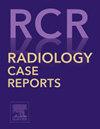Castleman disease mimicking accessory spleen on imaging: A case report
Q4 Medicine
引用次数: 0
Abstract
Castleman disease (CD) is a nonclonal lymphoproliferative disorder that causes non-neoplastic lymph node enlargement. With an incidence of approximately 21-25 cases per million, CD presents variably, often mimicking both benign and malignant conditions across various body regions. Clinically, it ranges from asymptomatic lymph node enlargement in Unicentric Castleman's Disease (UCD) to aggressive, multicentric presentations affecting multiple organs. Accurate diagnosis relies on surgical pathology due to the disease's diverse clinical and imaging manifestations. We report a rare case of UCD in a 19-year-old male who presented with mild, nonspecific left upper quadrant pain. Initial examinations, including ultrasonography, computed tomography, and magnetic resonance imaging, showed a hypervascular retroperitoneal mass that was initially suspected to be an accessory spleen or pancreatic tail neuroendocrine tumor.
Surgical resection and histopathological analysis established the diagnosis of hyaline-vascular type UCD. This case highlights the diagnostic challenges of UCD, particularly when presented in uncommon locations like the retroperitoneal peripancreatic region. Imaging often fails to conclusively differentiate CD from other vascular lesions, necessitating a histopathological evaluation. Prior case studies have also reported similar diagnostic challenges and the efficacy of surgical resection for treating UCD. This case report adds to the existing literature by outlining the diagnostic procedure and challenges associated with retroperitoneal UCD. This highlights the need for increased awareness, advanced imaging techniques, and histopathological confirmation to achieve accurate diagnosis and effective treatment. A multidisciplinary approach is critical in managing such complex cases, ultimately leading to favorable patient outcomes.
卡斯特曼病在影像学上模仿附属脾脏:病例报告
卡斯特曼病(CD)是一种非克隆性淋巴细胞增生性疾病,会导致非肿瘤性淋巴结肿大。CD 的发病率约为 21-25 例/百万人,其表现多种多样,通常会模仿身体各部位的良性和恶性疾病。在临床上,从无症状的单中心卡斯特曼病(UCD)淋巴结肿大到影响多个器官的侵袭性多中心表现,不一而足。由于该病的临床和影像学表现多种多样,因此准确诊断有赖于外科病理检查。我们报告了一例罕见的 UCD 病例,患者为一名 19 岁男性,表现为轻度、非特异性左上腹疼痛。包括超声波、计算机断层扫描和磁共振成像在内的初步检查显示,患者腹膜后有一个高血管性肿块,最初怀疑是脾脏附属瘤或胰尾神经内分泌瘤。该病例凸显了UCD的诊断难题,尤其是在腹膜后胰腺周围等不常见部位。影像学检查通常无法明确区分 UCD 和其他血管病变,因此需要进行组织病理学评估。之前的病例研究也报道了类似的诊断难题以及手术切除治疗 UCD 的疗效。本病例报告概述了腹膜后 UCD 的诊断过程和相关挑战,为现有文献增添了新的内容。这凸显了提高对该病的认识、采用先进的成像技术和组织病理学确认以实现准确诊断和有效治疗的必要性。在处理此类复杂病例时,多学科方法至关重要,最终可为患者带来良好的治疗效果。
本文章由计算机程序翻译,如有差异,请以英文原文为准。
求助全文
约1分钟内获得全文
求助全文
来源期刊

Radiology Case Reports
Medicine-Radiology, Nuclear Medicine and Imaging
CiteScore
1.10
自引率
0.00%
发文量
1074
审稿时长
30 days
期刊介绍:
The content of this journal is exclusively case reports that feature diagnostic imaging. Categories in which case reports can be placed include the musculoskeletal system, spine, central nervous system, head and neck, cardiovascular, chest, gastrointestinal, genitourinary, multisystem, pediatric, emergency, women''s imaging, oncologic, normal variants, medical devices, foreign bodies, interventional radiology, nuclear medicine, molecular imaging, ultrasonography, imaging artifacts, forensic, anthropological, and medical-legal. Articles must be well-documented and include a review of the appropriate literature.
 求助内容:
求助内容: 应助结果提醒方式:
应助结果提醒方式:


